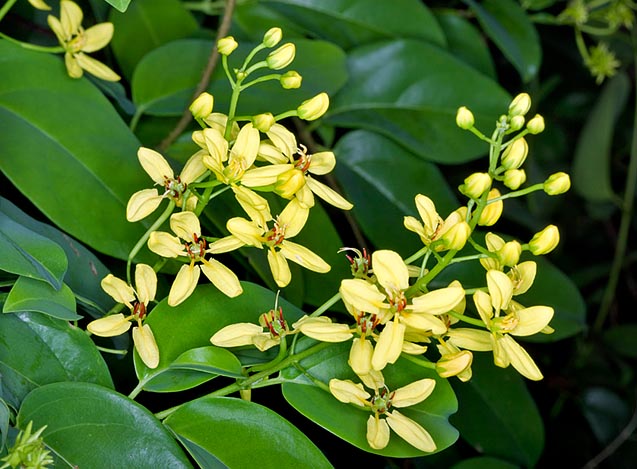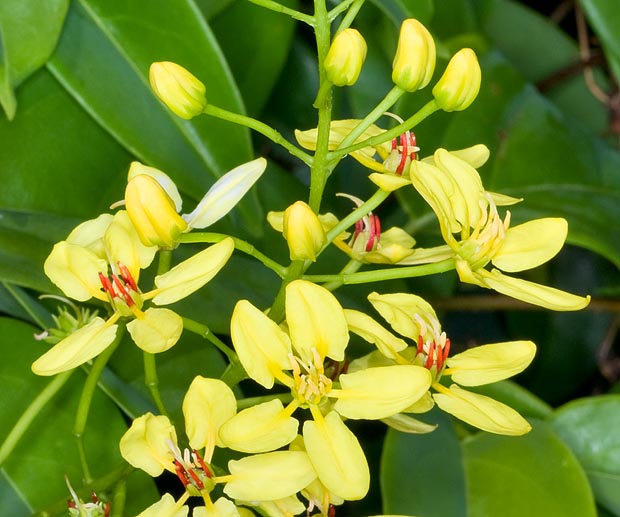Family : Malpighiaceae

Text © Pietro Puccio

English translation by Mario Beltramini

Galphimia glauca is a 1,5-2,5 m tropical shrub, with 7-15 cm inflorescences © Giuseppe Mazza
This plant is native to North America (Mexico: states of Chiapas, Hidalgo, Jalisco, Nayarit, Oaxaca and Puebla), Central America (El Salvador, Guatemala, Honduras and Nicaragua), and South America (Brazil), where it grows on open rocky slopes or in the deciduous forests.
The name of the genus is an anagram of Malpighia.
The name of the species comes from the Latin adjective “glaucus, a, um” = glaucous, greyish pale blue, with reference to the colour of the leaves.
Common names: golden shower, rain-of-gold, slender goldshower, spray of gold, thryallis (English); galfimia (Italian); gerbe d’or (French); trialis (Portuguese); botón de oro, calderona amarilla, festividad, nochebuena (Spanish).
The Galphimia glauca Cav. (1799) is a compact, 1,5-2,5 m tall, evergreen shrub, even if, when cultivated, it is kept lower, with thin frail branches, reddish when young. The leaves are simple, opposite, coriaceous, oblong, of green colour and covered by a waxy patina, bluish on the upper page, glaucous below, 2-7 cm long and 1-3 cm broad, with 1-2 glands at the base. The inflorescences are erect, 7-15 cm long, pyramidal, terminal racemes, carrying several flowers, of a bright yellow colour, with 5 ovate, about 1 cm long, petals, and ten fertile stamina. The fruits are globular, slightly tri-lobed capsules, of 6 mm of diameter, containing 3 seeds.

Flowers and leaves have medicinal virtues. The corolla has five 1 cm petals and 10 fertile stamina © Mazza
It reproduces by seed, in a sandy sub- stratum, at the temperature of 20-22 °C, and by semi-woody cutting in summer.
It is a robust species well known for its medicinal properties and in the meantime appreciated on the ornamental point of view due to its compact appearance, the thick foliage and the long lasting, bright and abundant flowering, so much copious to hide at times the underlying foliage.
As it is suitable for being cultivated, in full sun and in fertile and well drained soils, in the tropical, subtropical and warm temperate zones, its leaves are damaged at tempe- ratures by the -2 °C, lower temperatures, to around -6 °C, destroy the whole aerial part, but the plant will grow again from the base in spring. It is a plant which required little cares and bears fairly well the prunings, which are to be done after the blooming; it can be, therefore, utilized as isolated specimen, as well as for hedges, borders or thick informal barriers.
The well rooted plants are capable to resist to long periods of dryness, and consequently may be employed also in semi desert gardens. It adapts to the cultivation in pot, utilizing a sandy substratum rich of organic substance, for the decoration of greenhouses and luminous verandas, the watering are to be regular in summer, but allowing the first layers of soil to dry up before giving water again and must be spaced in winter.
Extracts of leaves and flowers are used in the traditional medicine and, widely, in homeopathy and phytotherapy in the allergic manifestations in general and as anxiolytic.
Synonyms: Malpighia glauca (Cav.) Pers. (1805); Thryallis glauca (Cav.) Kuntze (1891).
→ To appreciate the biodiversity within MALPIGHIACEAE family please click here.
